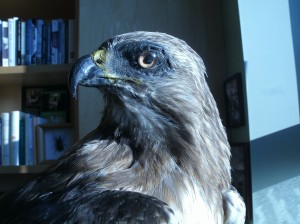By Ashton Nichols
I have a sad story to tell today. It is about one of those red-tailed hawks that I have written about in an earlier piece on The Roost, perhaps; or, perhaps not. Not so long ago, I was out in the locust and pine woodlot behind Creekside, and I saw a splash of brown and white against the green of the grass underneath one of our largest pine trees. Pine needles littered the ground, but this different brown stood out, a deep burnished color set off by the white lines that surrounded it. As I drew closer it was clear: this was a hawk, a dead hawk, and a big one, lying under the pine tree with his wings splayed and his head cocked to one side, unnaturally crooked as though he had tried to look too far behind him. A red tail.
“He is so beautiful,” I thought to myself and, since I was alone, there was no one to talk to in any case. What can I do? I knew it was a Federal offense to possess even the dead carcass of a raptor. These birds are so valuable as species, and especially as consumers of carrion, that even American citizens can only report dead raptors and then let the Department of Natural Resources take over. Otherwise, we would be awash in the bodies of small, dead mammals, rodents of all kinds: rats, and mice, and voles, and more. But then I remembered something else: Dickinson College, where I teach, has permits–both state and federal–that allow for the obtaining raptor specimens, as long as they will be used solely for educational purposes. Of course, what else would I use this hawk for? Not just to sit on my mantel like a hunter’s trophy. Not just to hide away in a private collection of once-living specimens. Here was a beautiful creature, dead now for who knew what reason, and starting to rot back into the ground unless I intervened. So I did.
I got a large plastic trash bag and spread my hands wide on both sides, lowering the bag down over the body of the hawk. I picked him up, and I thought for a moment that he moved, but then I checked his eyes–one was clouded, the other one was closed–and so I was assured that he had breathed his last breath. (I keep saying “he” in full knowledge that I do not know his gender; sexing birds is very difficult, primarily because their sex-organs, such as they are, are all internal, and they are very often very hard to see and even harder to determine). As fast as I could I got him to our out-building, a large nineteenth-century, chimneyed structure that was used as the summer kitchen back in the day when Creekside was built. Once there, I placed him in the refrigerator’s freezer, closed it tight, and called Dickinson to make sure that I had access to our permits.
I did have such access, and several weeks later I contacted the best taxidermist in South-Central Pennsylvania to help me out. We met and made a plan, and he took the hawk and placed it into his own freezer until he had sufficient time to work on it. Birds are perhaps the most difficult of animals to stuff, primarily because of their feathers, evolutionarily adapted scales–from their lizard-skin days–that often “slip” when even the slightest bit of rot has begun to decay the cells around the follicle. The follicle is a small cavity, just like the one that holds your individual hairs into your head, but in a hawk’s case the follicle keeps the feathers from falling out. The taxidermist assured me that I had gotten him into my freezer in time, and he would make a fine mounted specimen. At least, that is what the taxidermist said.
Several months later I had my result, and here he is:
He is as beautiful a specimen as you will ever see, stuffed in the perfect way that makes me worry–and ask my students–about why it is that human beings like to take dead animals, return them to a lifelike condition, and then display them as though nothing has ever happened to them, as though they are still alive. I have been to natural history museums from New York to Naples, from Philadelphia to Florence, from London to Bologna, from Edinburgh to Rome and, in all of these settings I have wondered what it is that causes humans to track down these creatures, capture and kill then, and then finally display and exhibit them as though all of them are still among the living creatures on the planet.
I have no definitive answer to these questions. “I have killed and mounted this creature, so I am in control of its life,” is, of course, the most obvious answer. In colonial settings, we might say that every colonizer wants to say, at some level, “Look at what I have done; I have gone to the wilds of Africa [or Asia, South America, or the Arctic realms], and I have brought back these creatures and dominated them to such an extent that I can show them off to you now in a mighty civilized city.” But perhaps such an explanation is not sufficient. Perhaps we all collect, and kill [I work hard never to kill], and then display these creatures simply out of a desire to know them, a desire to possess, not out of greed, but out of a longing for knowledge, a longing for understanding. If I have this creature, then I am a part of this creature’s world. “I want to know you,” we seem to be saying; “I want to know you as well as other members of your species, and other species around you, know you.”
“Let me into your world,” we seem to be saying; and here is as close as we can ever get:


